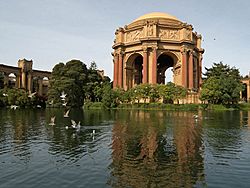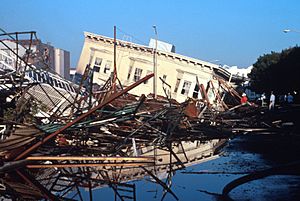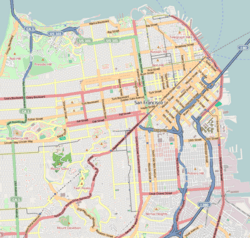Marina District, San Francisco facts for kids
Quick facts for kids
Marina District
|
|
|---|---|

The Palace of Fine Arts, a replica of the one built for the Panama–Pacific International Exposition, is a landmark of the Marina District.
|
|
| Nickname(s):
The Marina
|
|
| Country | |
| State | |
| City-county | San Francisco |
| Area | |
| • Total | 2.02 km2 (0.778 sq mi) |
| • Land | 2.02 km2 (0.778 sq mi) |
| Population
(2008)
|
|
| • Total | 12,071 |
| • Density | 5,989/km2 (15,511/sq mi) |
| ZIP Code |
94123
|
| Area codes | 415/628 |
The Marina District is a cool neighborhood in San Francisco, California. It's built on the spot where the huge 1915 Panama–Pacific International Exposition took place. This big fair was held after the 1906 San Francisco earthquake to show how the city had recovered. Except for the famous Palace of Fine Arts, all the fair's buildings were taken down to create the neighborhood you see today.
Contents
Where is the Marina District?
This area is bordered by Van Ness Avenue and Fort Mason to the east. To the west, you'll find Lyon Street and the Presidio National Park. On the south side, it's next to Cow Hollow and Lombard Street.
The northern part of the Marina District is right along the San Francisco Bay. Here, you'll find the Marina Green, which is a park next to the boat marina. The neighborhood gets its name from this marina.
A lot of the Marina District is built on landfill. This means the land was created by filling in parts of the bay. Because of this, the ground can become like quicksand during strong earthquakes. This effect, called soil liquefaction, caused a lot of damage during the 1989 Loma Prieta earthquake.
A Look Back: History of the Marina

Before the 1906 San Francisco earthquake, this area in the 1800s was mostly shallow bay water, marshland, and sand dunes. Over time, people started to build here. They created a road from the nearby Presidio to Fort Mason. Most of the sand dunes were flattened, and some wharves and factories were built. However, the 1906 earthquake destroyed everything.
From Exposition to Neighborhood
After the 1906 earthquake, San Francisco began to rebuild. The Marina area was chosen for the Panama–Pacific International Exposition. This big fair needed a lot of land. While some earthquake rubble was used, most of the new land came from dredging mud and sand from the bottom of the Bay.
When the exposition ended in 1915, the land was sold. Developers then tore down almost all of the fair's attractions. They built the residential neighborhood we know today. This major building project was finished in the 1920s. Later, in the 1930s, the Golden Gate Bridge was completed nearby. This led to Lombard Street being widened and becoming a popular spot for roadside motels.
The 1989 Earthquake's Impact
The 1989 Loma Prieta earthquake caused serious damage in the Marina District. The ground, made of landfill, turned to liquid in a process called liquefaction. This led to buildings collapsing and even a small firestorm. Firefighters had to pump water directly from the Bay because the regular water mains were broken. Luckily, the neighborhood was rebuilt quickly. Today, it still looks much like it did when it was first built in the 1920s.
Fun Things to See and Do
The most famous landmark in the Marina District is the Palace of Fine Arts. This beautiful building used to house the Exploratorium, a hands-on science museum. The Palace and its surrounding grounds are a popular spot for both tourists and locals all year round. Many people also choose it as a beautiful background for wedding photos.
Another popular spot is Chestnut Street. This street is full of cool stores, restaurants, bakeries, coffee shops, and bars. It's a lively place to explore! The neighborhood is also home to many young professionals in their twenties and thirties.
San Francisco's Academy of Art University has a campus housing building on Lombard Street, at the southern edge of the neighborhood.
Learning in the Marina
The Marina District is part of the San Francisco Unified School District (SFUSD). Students in this area attend Sherman Elementary School. As of 2018, Sherman Elementary had about 20 teachers.
See also
 In Spanish: Marina District (San Francisco) para niños
In Spanish: Marina District (San Francisco) para niños


